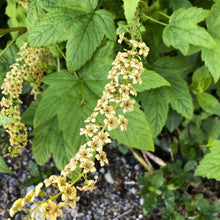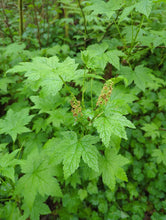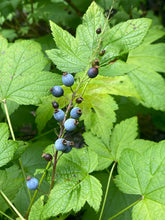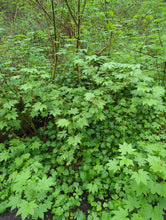
Ribes bracteosum
Blue currant is a unique, deciduous large shrub with maple-shaped leaves that offers a verdant, textured backdrop in moist areas of woodland gardens. Locally native to the Portland metro area, but quite uncommon to see both in nature and in the nursery, it sports clusters of pendulous spring flowers that stand upright or dangle up to a foot long from its branch tips. The flowers range in color from hues of greenish-white to soft pink and beige, then give way to drooping dusty blue-black berries in the late season, which are technically edible but primarily enjoyed by a plethora of birds. All parts of the plant are peppered with tiny yellow glands that emit a skunky-sweet smell, particularly noticeable when the leaves are crushed.
- Plant type/canopy layer: deciduous, perennial, large shrub
- Size at maturity: 4-12' tall, 6-10' wide
- Light requirements: part-sun/part-shade, full shade
- Moisture requirements: moist to seasonably wet soil
- Growth rate/ease: medium growth rate, easy to grow
- Bloom time: April – July
- Wildlife support: flowers attract and provide nectar to hummingbirds, adult butterflies, bees and other insect pollinators; fruits are an important food source for songbirds; overall plant attracts and supports beneficial and pest eating insects and is a caterpillar host plant and larval food source for native butterflies and moths
- Native range: grows along mountain streams, seeps, wet thickets and other moist forest areas, from the lowlands to the mountains, mostly west of the Cascade crest from southern Alaska to northwestern California. Portland Plant List - yes.
- Special features & uses: wildlife favorite; edible berries have been consumed by indigenous peoples for thousands of years, though mealy and described as having a wide range of flavors from unpleasant, to bland and even (rarely) delicious, they can be sweetened and used in preserves and pies; the Quileute removed the pith from the stem and used them to inflate seal stomachs that were used to carry oil; leaves were used to cover hemlock bark containers in which elderberries were stored; landscape uses include erosion control, habitat hedgerows, pollinator gardens, raingardens and woodland gardens
Gardening with Blue Currant: Blue currant is relatively low-maintenance, making it a reliable choice for gardeners seeking to add biodiversity, beauty and ease. Start by selecting a spot with partial to full shade that is protected from harsh afternoon sun. This species is not especially picky about soil type or texture, so long as it's moist, but placing it in areas with good drainage that are rich with organic matter will ensure robust growth. Consider providing deep, infrequent waterings during the summer drought, particularly in drier areas.
Photo Credit 1 (flower cluster): © emma reader-lee, some rights reserved (CC-BY)
Photo Credits 2 & 4 (foliage, wild understory): © John Brew, some rights reserved (CC-BY)
Photo Credit 3 (berries): © Hill Craddock, some rights reserved (CC-BY)







